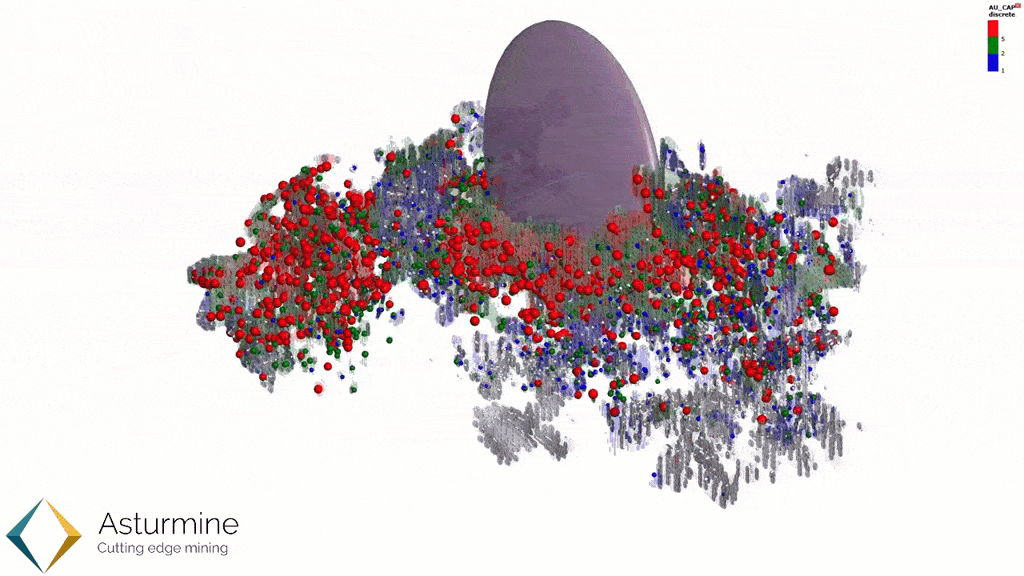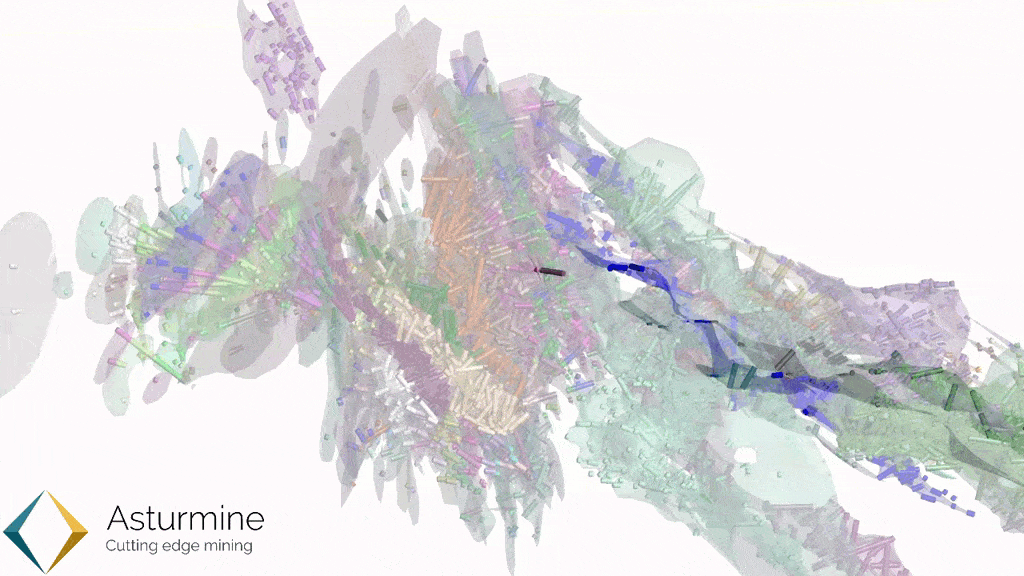Asturmine is a mining consulting company that switched from explicit modelling and manual data entry to a connected, dynamic workflow – improving sustainability and efficiency for clients.
Asturmine is a tech start-up that was founded in Asturias, Spain: a world-famous mining district. The mining consultancy developed a grade control mining project for a polymetallic mine in Kazakhstan.
Building a high-grade mineralisation model involves great technical complexity due to the nature of the mineralisation process. At the Kazakhstan deposit, Asturmine’s main challenge was producing an accurate resource estimation on discontinuous veins of mineralisation. The geology had complex structural controls, a high nugget effect, and a very short distance correlation.

Traversal sections of the vein modelling process. (Credit: Asturmine)
Exhausted modellers and inaccurate data from manual processes
Before Leapfrog Geo and resource estimation extension Leapfrog Edge, the Asturmine modelling team’s work was exhaustive and intricate. In order to generate orebodies, they had to manually draw them: digitalising each drillhole section-by-section with polylines and then joining the sections into a solid shape.
Then, after the generation of the geological domains, they had to be exported into another software to do the geostatistical analysis and estimation.
Due to the number of import/export phases in the process and the manual data input, there were countless errors inside the individual geological domains.
As the project progressed, the information available grew exponentially as new drillholes, underground maps, and analytical results were added. Consequently, the number of veins and geological domains multiplied, and the tedious manual digitalisation became a burden for modelers.
That’s why Asturmine chose Leapfrog Geo and Leapfrog Edge to add digital, dynamic modelling to their workflow.
“Since the incorporation of Leapfrog Geo into the modelling process and Leapfrog Edge to perform the resource estimation calculations, our time has been reduced by almost 30%,” says Juan Antonio Fernández García, co-founder and Senior Mining and Geological Engineer at Asturmine.
Saving crucial time with dynamic modelling
The first big benefit of the switch was to their resource model construction. Dynamic updating allowed the modeler to build the geological domains just once and then, as new data was added, the model would update automatically in both Leapfrog Geo and Leapfrog Edge .
This automation removed the need to manually update the vein model with new data.
“Before, the modelling of a complex mineral deposit took approximately eight months of work. With Leapfrog Edge, we now take two months to model more than 700 veins and domains, and we are able to update the estimation frequently,” says Juan.
On the estimation side, their process improved in a similar way. Geologists only had to generate one configuration of the estimation and revise it when needed, instead of recreating it every time that new data came in.
Also, having an interactive 3D variogram model allowed them to visually validate their data, reducing errors in modelling. If changes were needed, the variogram model could be quickly reviewed and adjusted in Leapfrog Edge, making the process a lot more efficient.

Variogram model made in Leapfrog Edge displaying the scene in 3D. (Credit: Asturmine)
A big advantage for Asturmine’s clients was that they got results faster. With improved efficiency in modelling and updating, Asturmine could send clients revised resource models more frequently, allowing the mine management and design departments to update their plans more often.
Their clients could now respond to new information faster and refocus their targets based on the latest data: improving success and avoiding risks.
“This quality information provided every month to clients allows the planning department to adjust the underground design in advance, decreasing the number of errors on site,” says Juan.
Less environmental impact and reduction of risks for mining operations
During the mining project’s development, refining the mineralised domains became an important task for Asturmine. Since the mineralisation resulted in high grade veins, when they could define the target and calculate the width of the veins accurately, the mining design team could zero in on the targets’ locations, avoiding overextraction.
As well, by using Leapfrog Edge’s resource estimation tools, the mineral dilution in the host rock was reduced significantly, cutting down on the mining waste.
“There is no need to drill, blast, and extract unnecessary host rock. There is no energy wasted in overexploitation. There’s a 40% reduction in mineral dilution and its related costs with the new designs,” says Juan.
Asturmine’s grade control re-design of the Kazakhstan project resulted in targeting the mineralisation with high accuracy. The new design decreased the size of the galleries from five metres to three metres , massively reducing the environmental impact during the mining process.
Due to more precise modelling and calculations in Leapfrog Geo and Leapfrog Edge, the mine was able to accurately define its resources, reducing the volume of material mined. With less material taken out of the ground, the risk of metal contamination was also significantly reduced.
This enabled the mining company to effectively reduce its impact on the environment and local aquifers: vital for sustaining the lifetime of the mine.
“Leapfrog Geo is the most powerful tool for managing thousands of drillholes to understand a mineral deposit with precision and avoiding extra costs with proper planning. At the same time, it delivers a significant reduction in environmental impact and the hazards associated with a mining operation,”
Juan Antonio Fernández Garcíaco-founder and Senior Mining and Geological Engineer at Asturmine

3D view of the Kazakhstan Polymetallic Project. (Credit: Asturmine)
By improving the accuracy of the galleries and the mineral concentration, the mine could be incredibly efficient during times when metal prices were low, allowing them to continue operating.
Also, the periodic delivery of the up-to-date model and estimation allowed their client’s design team to review the layout of the galleries and reduce risks by designing adequate ventilation and ground support systems.
A better future for mining
Leapfrog Edge, Seequent’s resource estimation software, enabled Asturmine to combine modelling and resource estimation into one workflow. The regular updates that their clients required are now easy to deliver, saving time and costs.
Asturmine’s work is helping clients to reduce their environmental impact and operational risks, while improving safety in their work environment – leading to a better future for the industry.
“The better understating of the geology and the mineralisation, the more that mining companies can be cost-efficient in the design and extraction of an ore deposit. With Leapfrog Edge, this knowledge can generate better results, faster,” says Juan.





